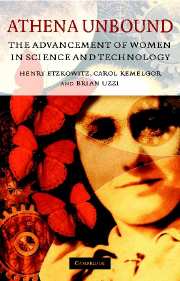Book contents
- Frontmatter
- Contents
- Acknowledgements
- Introduction: Women in science: Why so few?
- 1 The science career pipeline
- 2 Women and science: Athena Bound
- 3 Gender, sex and science
- 4 Selective access
- 5 Critical transitions in the graduate and post-graduate career path
- 6 Women's (and men's) graduate experience in science
- 7 The paradox of critical mass for women in science
- 8 The ‘kula ring’ of scientific success
- 9 Women's faculty experience
- 10 Dual male and female worlds of science
- 11 Differences between women in science
- 12 Social capital and faculty network relationships
- 13 Negative and positive departmental cultures
- 14 Initiatives for departmental change
- 15 International comparisons
- 16 Athena Unbound: Policy for women in science
- Appendix
- Bibliography
- Index
11 - Differences between women in science
Published online by Cambridge University Press: 08 September 2009
- Frontmatter
- Contents
- Acknowledgements
- Introduction: Women in science: Why so few?
- 1 The science career pipeline
- 2 Women and science: Athena Bound
- 3 Gender, sex and science
- 4 Selective access
- 5 Critical transitions in the graduate and post-graduate career path
- 6 Women's (and men's) graduate experience in science
- 7 The paradox of critical mass for women in science
- 8 The ‘kula ring’ of scientific success
- 9 Women's faculty experience
- 10 Dual male and female worlds of science
- 11 Differences between women in science
- 12 Social capital and faculty network relationships
- 13 Negative and positive departmental cultures
- 14 Initiatives for departmental change
- 15 International comparisons
- 16 Athena Unbound: Policy for women in science
- Appendix
- Bibliography
- Index
Summary
Overlying the differences between the male and female scientific worlds is another split, one within the female realm, that mirrors and refracts the larger gender division. Women scientists' perception of the obstacles in their path, and their response to them, create two dichotomous camps. One group is predominantly made up of an older generation of resilient women who stress a highly competitive, individualistic style that mirrors the traditional male stereotype. In contrast, younger up-and-coming junior and newly tenured women faculty members emphasize a more relational, collaborative approach within their research groups. We call the first group of women ‘instrumentals’, and the second ‘relationals’, reflecting their respective work styles. Notwithstanding such important differences, women faculty members who have thrived appear to have in common two significant characteristics. Firstly, they all identify sufficiently positive relationships with their own graduate school advisors as crucial to their past and present level of self-confidence, perseverance, and success. Secondly, although each is influenced by their own perception of a scientific style, all of these dedicated women labor to interpret an appropriate role as advisor to their female students.
Inescapable tensions exist for all successful women scientists, regardless of personal philosophy, around the role of advisor. The perceptions, attitudes and values which comprise a ‘style’ of advising and doing science are frequently a product of, or a response to, an earlier powerful relationship with one's mentor.
Information
- Type
- Chapter
- Information
- Athena UnboundThe Advancement of Women in Science and Technology, pp. 147 - 156Publisher: Cambridge University PressPrint publication year: 2000
